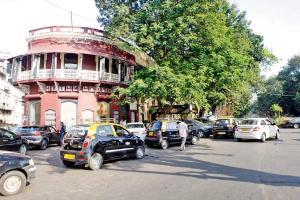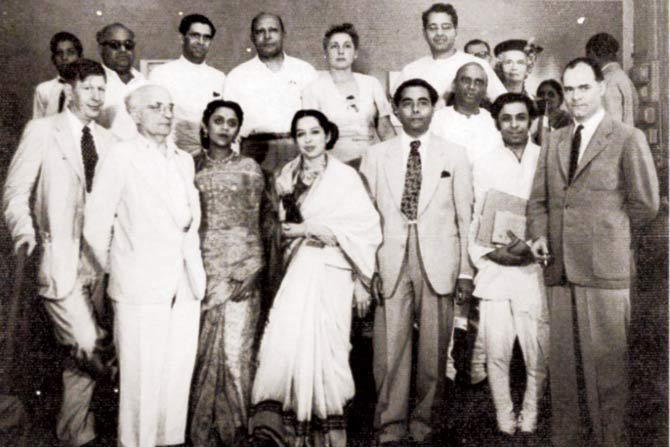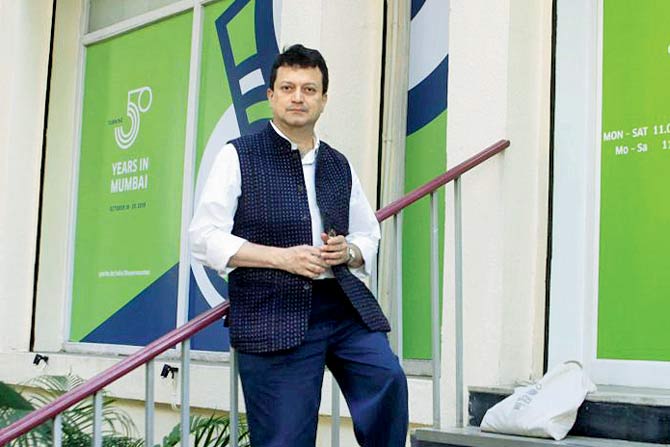Rambling down 100 metres of shifting-textured Rampart Row in the week Khyber turns 60 and the Wayside Inn proprietor 90

Corner of K Dubash Marg, earlier called Rampart Row for the Bombay Fort ramparts situated here. Pic/ Ashish Raje
 Few streets have more evocative names. Before becoming K Dubash Marg, the Kala Ghoda strip—from its eponymous, not-yet-riderless statue till the Church of St Andrew opposite Lion Gate—was Rampart Row. The former site of Bombay Fort's ramparts. Behind was Ropewalk Lane. William Milburn's Oriental Commerce (1825) notes: "Here is a rope walk. For length, situation and convenience it equals any in England… has covering to protect workmen; cables and all sorts of cordage, hemp and coir, are manufactured."
Few streets have more evocative names. Before becoming K Dubash Marg, the Kala Ghoda strip—from its eponymous, not-yet-riderless statue till the Church of St Andrew opposite Lion Gate—was Rampart Row. The former site of Bombay Fort's ramparts. Behind was Ropewalk Lane. William Milburn's Oriental Commerce (1825) notes: "Here is a rope walk. For length, situation and convenience it equals any in England… has covering to protect workmen; cables and all sorts of cordage, hemp and coir, are manufactured."
ADVERTISEMENT
On this tree-lined avenue stands possibly the city's oldest mahogany. Fronting Ador House, sentinel-like, it is one of a pair planted by missionary explorer Dr David Livingstone himself. The other borders Bombay Natural History Society's headquarters, Hornbill House, named after William, the hornbill that fluttered into their garden, to reign as the BNHS mascot. Sailing in on the Lady Nyassa for six months in town in 1865, Livingstone seeded the pinnate-leafed mahoganies at Governor Bartle Frere's behest. "Visiting dignitaries from Chou En Lai to Tito and Khrushchev were encouraged to sow trees," says botanist Ashok Kothari, suggesting we notice star apples outside Khyber too.
As a JJ College of Architecture pupil, Mustansir Dalvi savoured the precinct differently. "We frequented more modest joints, Madras Cafe and Military, not Khyber which was unaffordable. Now, when I can afford Khyber, I don't patronise it. Living at nearby Masjid Bunder, this area's bookshops were my priority."
 MF Husain at Wayside Inn in 1998 flanked by good friends Aziz (Munna) Jhaveri, whose Joy Shoes shop at the Taj was designed by Husain, and cafe proprietor Pervez Patel with grandson Kaizen. Pic courtesy/ Pinky Patel
MF Husain at Wayside Inn in 1998 flanked by good friends Aziz (Munna) Jhaveri, whose Joy Shoes shop at the Taj was designed by Husain, and cafe proprietor Pervez Patel with grandson Kaizen. Pic courtesy/ Pinky Patel
Jaywantsinhji Mansinhji (Mota) Chudasama acquired Thacker's bookstore, every discerning reader's haunt and distributor of leading British financial journals. "Erstwhile maharajas popped in for personalised stationery," says Dhanraj Bhagat, its CEO. "The Rampart Index Diary that Thacker's published enjoyed demand as a corporate gift."
Despite a directorial board including Rafiq Zakaria and RK Laxman, Thacker's downed shutters around 1990. "Though sad to see it go, I was thrilled at several books to keep," says painter Brinda Miller, daughter of Mota's younger brother Narendrasinhji Mansinhji (Nana) Chudasama and the Kala Ghoda Art Festival's moving spirit. "It's tragic that Artists Centre will soon be out of Ador House."
Her style guru cousin, Mota's daughter Monica Chudasama Vaziralli, dressed the best interiors with exquisite French period furniture from The Drawing Room. "The absolutely fantastic Kaye O'Neil ran it," she says, of the designer credited with the first Sea Lounge, Crystal Room and Jade Room avatars. Monica took over The Drawing Room from the '70s. Kaya Skin Clinic is in its place today.
 Congress for Cultural Freedom delegates at Chetana in 1951: First and second from left in the first row are poet WH Auden and pacifist Salvadore de Madariaga, second and third from right are writers Raja Rao and Sudhakar Dikshit who started Chetana. Fourth from left in the last row is Max Yergan, African American labour leader from the US. Pic courtesy/ Chhaya Arya
Congress for Cultural Freedom delegates at Chetana in 1951: First and second from left in the first row are poet WH Auden and pacifist Salvadore de Madariaga, second and third from right are writers Raja Rao and Sudhakar Dikshit who started Chetana. Fourth from left in the last row is Max Yergan, African American labour leader from the US. Pic courtesy/ Chhaya Arya
A classic-contemporary centre, doubling as the city's earliest art gallery, was Chetana ("awakening") from 1946. Journalist Sudhakar Dikshit and writer Raja Rao converted this from Sri Vidya Samiti's Peacock Restaurant and dance studio where Chetan and Uma Anand also conducted drama classes. Chetana sparked unique creative narratives. Meeting the Progressives here, MF Husain declared, "As you had the Bloomsbury Group in England, it's fair to call us the Chetana Group. Chetana was the nucleus of cultural life not just in Bombay but in India."
It had substance, it had soul. Waving the outside warmly in with big bay windows, Chetana amplified local voices from a freshly minted democracy. "My grandfather cultivated confidence in Indian talents, hoping self-esteem and individuality showed in whatever we did," says Kavi Arya. His mother Chhaya, the steady force behind Chetana's evolution, is Dikshit's daughter. Kavi's father was legendary lensman Jitendra Arya.
To its bookshop with a chess table, the centre added a thali restaurant and handlooms outlet. MV Kamath edited copy in lieu of a Chetana dosa and coffee. This was Damu Jhaveri's venue selling tickets for Indian National Theatre productions. On its 60th anniversary, Shyam Benegal said, "Chetana is the only constant—the Dhruva on charming Rampart Row."
 Vimal Satyal behind the cash desk of Bullock Cart. The disco restaurant with a cult following was designed rustic Indian but served Continental steak meals
Vimal Satyal behind the cash desk of Bullock Cart. The disco restaurant with a cult following was designed rustic Indian but served Continental steak meals
Smiles flood faces of a certain vintage at the merest mention of Bullock Cart. Hip in the hood, this disco-cafe was the baby of Ravi Kumar, son of musician Shankar Singh Raghuvanshi of the Shankar-Jaikishan duo. Where Copper Chimney rose later, Bullock Cart rocked from 1969 to '72. Its cult following happily ended daytime disco sessions with Nights in White Satin under ultra-violet lighting. "I sometimes bunked St Xavier's to dance there in mini-skirts," laughs Jeroo Mulla, retired head of Sophia College's Social Communications Media course.
Excited reminiscing on the phone from Australia where he settled, Bullock Cart cashier-manager Vimal Satyal says, "I think we were the country's only A-Grade standalone restaurant offering beef, on menus printed in German with English translations. Foreign fans included actors Michael York and Joanne Woodward, the Aussie and New Zealander cricket teams."
Among fashion shows at Bullock Cart were those by Golden Thimble, Munira Chudasama's boutique customising tasteful couture for 55 years. She says, "We were like-minded neighbours down the row. Uma Dubash, Parmeshwar Godrej and Dimple Kapadia were clients turned friends. Married to Rajesh Khanna, Dimple would puff away, chatting, comfortable in our confidentiality. One afternoon my staff missed asking a customer his name when I was out. They said he came barefooted. I knew which painter was looking for me to create his daughter Aqueela's wedding trousseau."
Munira's daughter Shaina NC introduced her sarees 30 years ago at the store, with 54 ways of wearing each. Holding the Guinness record for draping these metres fastest, Shaina has Aishwarya Rai to Cheri Blair loyal to her collections.
 Australian cricketers Graham McKenzie and Brian Taber at Bullock Cart. Pics courtesy/ Vimal Satyal
Australian cricketers Graham McKenzie and Brian Taber at Bullock Cart. Pics courtesy/ Vimal Satyal
Arun Kolatkar's Kala Ghoda Poems mirror a streetscape of stray dogs, beggars and his weekly haunt, The Wayside Inn, on Table No. 4 of which Babasaheb Ambedkar drafted the supreme law of the land. "Bent over the Constitution's pencilled foolscap sheets, he occasionally requested a pen," recalls proprietor Pervez Patel. After lunch, KH Ara once led Patel to Artists Centre displaying "reasonably priced" works. "Seeing his famous nudes, I explained two under-8 children were waiting back home!"
Those of us dating in the '80s slipped into such cosy cafes. I was popped the question at Wayside, over the then popular "mixed grill" meal—a single portion, shared—we were both slender-salaried. Romance the heady essence of Rampart Row, how could I not have said, Yes?
In conversation with poet, cultural theorist, curator Ranjit Hoskote
 Ranjit Hoskote at Max Mueller Bhavan, his 1980s Elphinstone College years' hangout among other Rampart Row favourites Jehangir Art Gallery, Samovar, Rhythm House, Madras Cafe, Thackers and Chetana. He often dropped in at Wayside Inn, joining poet Arun Kolatkar's circle at jour fixe Thursday teatime meetings. Pic/ Ashish Raje
Ranjit Hoskote at Max Mueller Bhavan, his 1980s Elphinstone College years' hangout among other Rampart Row favourites Jehangir Art Gallery, Samovar, Rhythm House, Madras Cafe, Thackers and Chetana. He often dropped in at Wayside Inn, joining poet Arun Kolatkar's circle at jour fixe Thursday teatime meetings. Pic/ Ashish Raje
What was this 1950s-90s neighbourhood like?
Its institutions sustain the collective self-image of an arts quarter—which is wonderful in the vital process of urban regeneration. This wasn't always so. In the 1990s, Rahul Mehrotra and Sharada Dwivedi proposed Kala Ghoda as an arts district, with potential cultural infrastructure. Beginning to show genteel decay, Rampart Row had drug dealers in lanes after office hours.
Between 1950 and '70, Kala Ghoda was lively with Kamaladevi Chattopadhyay's Bharatiya Natya Sangh, the French reading room Le Cercle Litteraire, Artists Aid Centre (later Artists Centre), Jehangir Art Gallery, Chetana and Samovar. The Museum was guided by stellar figures like Karl Khandalavala and Moti Chandra, Rhythm House was home for generations of enthusiasts of varied music idioms. No one framed this as a phalanx before Rahul and Sharada made their ideas public and the Kala Ghoda Association formed.
Have high-end boutiques edged out simpler cafes and shops?
The dramatic last decade change isn't necessarily elitist or exclusionary. Terms for Kala Ghoda's shifting space used are "gentrification" and "downtown", neither a universal phenomenon. "Gentrification" described post-War 1950s London's working-class neighbourhoods taken over by middle-class leaseholders converting cottages and mews housing into villas and rowhouses. "Downtown" referred to 1980s New York and Chicago business districts reinventing, flattening socio-economic diversity for shiny images of prosperity. These terms don't apply to Bombay, an interstitial metropolis with wealthy enclaves adjacent to shanties. Kala Ghoda newcomers replace small manufacturing units, but traders, ancillary services, street eateries are still alongside, with no entry ban.
How do new restaurants compare with the earlier katta culture?
The katta culture is a bit of a myth. The adda culture really flourished at Wayside Inn and Chetana. Grotty, bohemian bars and dives were on Arthur Bunder Road. The new Kala Ghoda restaurants mark an emergent sociology of hybrid use, effective as co-working spaces, intermediate platforms between leisure and work.
Your take on the Kala Ghoda statue?
The original was an equestrian sculpture of the Prince of Wales, the present one simply a horse. It's a mnemonic, a handy device anchoring the otherwise unremarkable parking lot. Champions of the idea meant well, but the horse falls short of making a significant statement.
Catch up on all the latest Mumbai news, crime news, current affairs, and also a complete guide on Mumbai from food to things to do and events across the city here. Also download the new mid-day Android and iOS apps to get latest updates
 Subscribe today by clicking the link and stay updated with the latest news!" Click here!
Subscribe today by clicking the link and stay updated with the latest news!" Click here!







